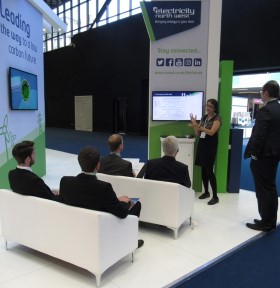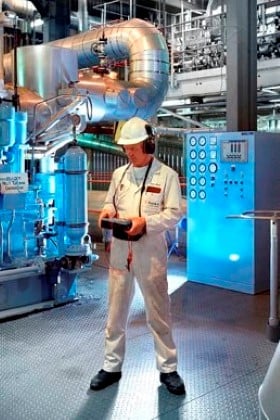Innovation update October 2016
Innovation update - October 2016
Welcome to the second issue of our quarterly e-newsletter, Innovation Update. This regular update will provide you with the key highlights from our innovation portfolio. We hope you find it of interest.
Flying the flag at our industry conference

Earlier this month our colleagues attended the Low Carbon Networks and Innovation Conference at Manchester Central. As the conference took place in our region, the event was co-hosted by the Electricity Networks Association and ourselves. This meant we had a great opportunity to promote our brand and fly the flag for Electricity North West.
Around 1300 delegates attended the three-day event which showcased the industry’s network innovation projects through a programme of project-focused presentations and workshops.
Our innovation team presented on a number of themes, including a workshop on our strategy for the future of customer service, and our key innovation projects: Celsius, Respond, Smart Street and CLASS. There was also an opportunity to share findings from our smaller-scale projects on oil regeneration and demand scenarios.
Our chief executive Peter Emery, said: “Electricity North West is recognised as being the leader in this work and the conference gave us the opportunity to showcase and share learning from our projects. It was also great to see colleagues from across the business experiencing the event.”
Engineering and technical Director, Steve Cox, said: “This year’s event has been better than ever. It’s a fantastic way to see firsthand how our sector is changing. It was also a great year for Electricity North West as co-host. Our new exhibition stand stood out from the crowd with our distinctive branding and the creative ways we used to promote our innovation strategy and our projects.”
Respond

Our low carbon project, Respond, will deliver an intelligent approach to managing fault current – the instantaneous surge of energy which occurs under fault conditions.
Respond is a revolutionary solution to the issue of increasing fault level on the network and will bring significant savings for our customers. The £5.5 million project, which runs from January 2015 until October 2018, will maximise the use of our existing assets, reduce costs to customers and speed up the connection of new demand and generation.
Following the successful installation of the Respond fault level mitigation equipment, Adaptive Protection and the Is-limiter, the project entered the trials and analysis phase in May this year. Our regulator Ofgem visited our Respond sites in September to see the work for themselves.
Since going live there have been three 11kV network faults which resulted in the successful operation of the Adaptive Protection installed at Atherton Town Centre 33/11kV primary substation.
In order to prove the Respond technology, the protection settings of the fault level mitigation techniques at all Respond substations have been adjusted to operate for particular fault types and magnitudes. In the case of Atherton Town Centre, the Adaptive Protection was triggered, causing the 11kV bus section to open within 100ms, allowing the 11kV feeder breaker supplying the fault to operate as normal but breaking fault current which is approximately half the usual levels.
The process of gathering fault data following each event is very important for post-fault analysis. Each successful operation of the technology is validated by our partners WSP Parsons Brinckerhoff and a report is published on the project website three months after the event. These reports will validate the real time operational results against simulated results using our IPSA+ master model and future network management system. This will help with project learning and tuning the respective network models to ensure that the data is as accurate as possible.
Celsius

Celsius is the first of our projects to be funded under Ofgem’s Network Innovation Competition.
The £5.5 million Celsius project will explore innovative, cost-effective ways of managing potentially excessive temperatures at distribution substations and is the first solution of its kind in Great Britain. Celsius will release additional capacity, reduce long-term costs for customers and avoid early asset replacement.
The first stage of Celsius is to gather data from 520 substations, using new temperature monitoring equipment. The data will be analysed to improve our understanding of the relationship between an asset’s temperature, load and environment and to develop a ‘Thermal Ratings Tool’. Secondly, a range of cooling techniques will be trialled on 100 of the distribution substations to demonstrate the benefits of each technique.
Since our last update the monitoring equipment has been tested and approved and we have launched the back end data management system. Installation of monitoring equipment for the first trial period began earlier this month. As part of this work we have developed a commissioning application to track installation progress and to enable installation teams to accurately and safely apply the equipment.
The commissioning application works on a smart phone and guides the installation team through the process. It provides live data feedback to ensure the installation process has been successfully completed and reduces the risk of multiple site visits.
Our next step is to use the learning from Celsius to drive changes and influence existing industry policies and standards. We will be holding our first DNO workshop in November to review Engineering Recommendations P15 and P17, and highlight areas where Celsius can enhance these recommendations.
Value of Lost Load

Electricity supply interruptions have financial and social impacts on customers, which vary by season, time of day, customer load and customer type. Understanding this value of lost load (VoLL) is important in network planning and investment strategy and will become increasingly important as customers become more reliant on electricity in the low carbon future.
The electricity industry uses a financial model to calculate the cost and impact of power cuts which guides many important decisions. The model is used by Ofgem to impose penalties and incentives on distribution network operators (DNOs) like Electricity North West to drive down the frequency and duration of power cuts. It is also used by DNOs in their investment decisions to ensure funds are targeted in the right areas.
Our VoLL project is an extensive piece of research which will lead to a better understanding of the unique impact of power cuts on a diverse range of customers. This research will help us develop a revised financial model that will lead to fundamental changes in the way the industry assesses the value of power cuts to specific customer segments. This will ensure that future investments are targeted at the areas of our network which will benefit our customers the most.
Earlier this year we conducted focus groups and ‘depth’ interviews with a cross-section of customers and stakeholders who are likely to be in contact with or support customers during a power cut. Insight from this research helped us develop a customer survey which has been piloted with 700 customers. Early indications show that our methodology is robust and we are confident of producing a reliable segmentation model.
The final survey instrument will be reviewed and refined following feedback from the pilot before launching a large scale customer survey. A further 6,000 surveys will be completed across Great Britain, (5,000 domestic customers and 1,000 small to medium enterprises). The interviews will be conducted in two phases, winter 2016/17 and summer 2017, with 50% of each customer type in each phase. This will help to identify any seasonal changes in perception of VoLL and how such changes vary within each segment dependent upon recent experience of a power cut.
The interim findings can be found on our project website. The final report will be published in January 2018.
Demand Scenarios and ATLAS

Credible scenarios of future demand and generation – which reflect the associated uncertainties – are key to efficiently planning our distribution network. Two of our Network Innovation Allowance (NIA) projects address this. Our ‘Demand Scenarios with Electric Heat and Commercial Capacity Options’ project will close at the end of 2016. It has developed and implemented a revised methodology for producing annual peak demand scenarios per substation for the Electricity North West region. The best view was used in strategic planning and regulatory reporting this year. As part of developing the evidence base, we have researched the long-term impact of domestic heat pumps and air conditioning on peak demands in winter and summer. We have also developed a prototype tool which uses our demand scenarios to inform decisions about when to provide network capacity via a traditional reinforcement or by demand side response.
Our ATLAS ‘Architecture of Tools for Load Scenarios’ project began last year and runs to December 2017. ATLAS builds on our work on peak scenarios. It is developing the methodologies, tools and specifications for the more detailed regional loading scenarios and comparisons to capacity which DNO networks will need in future to plan the network. Importantly this will cover seasonal peaks and minima, and half-hourly analysis. It will reflect the differences between measured demand and underlying true demand, due to the effects of local generation. ATLAS will also cover active and reactive power flows. There is a trend towards increasing export of reactive power from distribution to transmission, due to falling minimum measured demand and its interaction with our EHV network. This is bringing challenges for National Grid in controlling voltage on its network. ATLAS is delivering the first integrated approach by a DNO to deliver long-term scenarios of active and reactive power, across its network from primary substations to grid supply points.
Further information on both projects is available on our website.
Useful links
Earlier this month we published the first closedown report for one of NIA registered projects. Distribution Asset Thermal Modelling was a research project looking at thermal ratings of LV cables and distribution transformers. A significant proportion of the learning has been used to inform, and will be developed further within, our Celsius project. The findings can be found at www.enwl.co.uk/niaprojects.
You can find out more detailed information about all of innovation projects using the following links:
- Our LCNI conference presentations and video at www.enwl.co.uk/lcni2016
- Our new innovation strategy published in March 2016: www.enwl.co.uk/innovation-strategy
- Our LCN Fund project Smart Street: www.enwl.co.uk/smartstreet
- Our LCN Fund project Respond: www.enwl.co.uk/respond
- Our NIC project Celsius: www.enwl.co.uk/celsius
- Our NIA project Value of Lost Load: www.enwl.co.uk/voll
- Our other NIA projects: www.enwl.co.uk/nia
- Meet the Electricity North West innovation team: Meet the team
- The Electricity Networks Association smarter networks portal: www.smarternetworks.org
- Our NIA project ATLAS: www.enwl.co.uk/atlas
- Our NIA project Demand Scenarios: www.enwl.co.uk/demandscenarios
Or contact us at innovation@enwl.co.uk